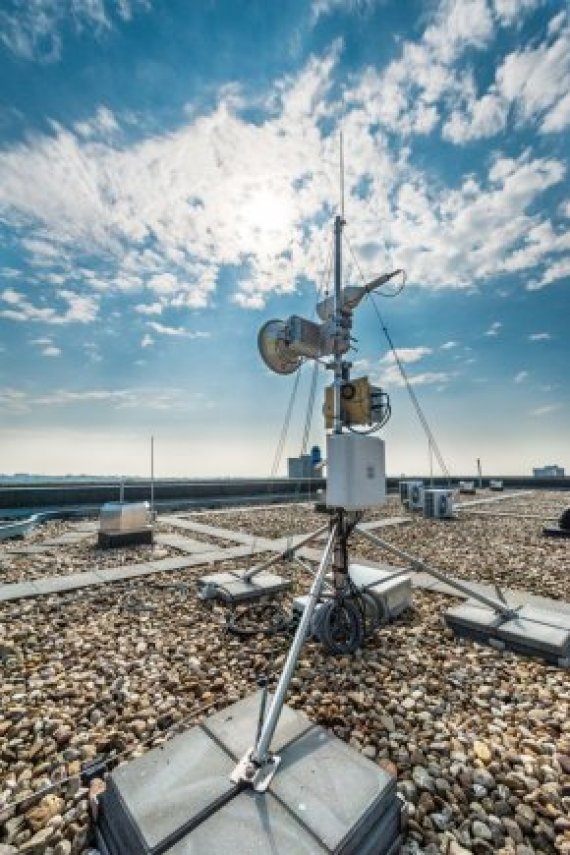A case of coincidental research, professor of Hydrology and Quantitative Water Management Remko Uijlenhoet calls this project. It emerged and grew from knowledge gained from chance encounters. It happened like this. At the end of the 1990s, through colleagues at the Meteorology and Air Quality chair group, Uijlenhoet came across a machine called a scintillomter. ‘This is a piece of equipment for measuring turbulence in the border layer of the atmosphere using fluctuations in the signals received. They had borrowed one which uses a frequency of 27 GHz,’ explained Uijlenhoet. ‘At exactly that frequency, the suppression of the signal is in proportion to the intensity of the rain. A colleague asked whether that could be of interest for measuring rainfall. Of interest? That correlation is fabulous!’ Uijlenhoet and his colleagues lost no time in setting to work. Two months and many measurements later, it was clear that the principle worked. The scintillometer they used was made at the Technical University of Eindhoven. When they asked whether another one could be made, they got a surprising answer. ‘Made? The country is full of them: they provide the microwave links used for mobile phone networks. You can use them to measure rainfall in the same way. Through a contact with a technician at Vodaphone, we got two months-worth of data from a few microwave transmitters in the Wageningen area.’ An MSc student started working on that, but before the results of the follow-up tests had been fully worked out, an article was published in Science by Israeli researchers who had been working on the idea. ‘We were really fed up about that,’ admits Uijlenhoet frankly.
Privacy
Before we go any further, we should clarify why Uijlenhoet is keen to measure rainfall. After all, we’ve already got the ‘rain radar’, haven’t we? ‘That’s true,’ agrees Uijlenhoet. But it could be improved on. ‘The two radar masts used by the KNMI [royal meteorological institute] are positioned in De Bilt and Den Helder. The further you are from the radar masts, the less precise the forecast. Precipitation information around the borders of the country is therefore less precise. As well as that, radar has the disadvantage of being an indirect measurement. Radar measures the rain not on the ground but in the air, at an average altitude of about 1.5 kilometres. You always have to correct the data using data from traditional rain gauges on the ground. Especially for use in hydrology and water management.’ Gauging rainfall on the basis of signals from microwave links does not in theory have that disadvantage. The antennae are close to the ground. This is enough reason for the KNMI to get involved in the project through radar expert Hidde Leijnse and Wageningen postdoc Aart Overeem. The technique is based on a control signal that transmitter masts routinely give off. Uijlenhoet: ‘Every so many minutes the minimum and maximum capacity of that signal is measured and recorded, to check whether the transmitter is still on air. Rain suppresses that signal and we make use of that.’ Uijlenhoet emphasizes that nobody need fear for their privacy. ‘There is no other information in that signal. We are only interested in the suppression of its strength. The great thing is that there are so many of these transmitter masts. The total network of masts from all mobile providers in the Netherlands adds up to 5000 microwave transmissions with an average reach of three to five kilometers. ‘So in principle there are 5000 rain meters which could measure continuously in real time on a scale appropriate for water management.’
Drops
So the first round in the contest for a place in Science was lost, but the research went on. Uijlenhoet’s group collaborated with T-Mobile on follow-up trials. Uijlenhoet: ‘Since then they have been providing data from thousands of transmitters, on the basis of which we can produce a precipitation map of the whole country every quarter of an hour. That research led to a publication in PNAS. That felt like revenge, I must say.’ The latest experiments on the roof of the Forum and Biotechnion aim at perfecting the rainfall measurements. The question is, how can you optimize the conversion of the suppression of the signal into rainfall data? The size of the raindrops is particularly significant, it appeared from theoretical calculations. For this reason, the installation includes a ‘disdrometer’, a piece of equipment which measures the size and falling speed of individual raindrops. Even more important than competing with the Dutch rain radar is the potential application of the system elsewhere in the world. In Africa, Latin America and parts of Asia where there are very few rain meters, the system has the potential to fill a big gap. Uijlenhoet: ‘Mobile telecommunication is nearly everywhere these days, so there are microwave links there. But will it work there too? The masts are a lot further apart and the frequencies used are lower. Can you still take reliable measurements under those conditions? Will the standard error be bigger or different? Together with the KNMI and the government, we are working on testing this on the spot in Brazil. We will get the first data in soon. There is also a project under way in Burkina Faso.’ Around the world there are a handful of groups working to get the new measuring technique up and running, says Uijlenhoet. The availability of data is essential to this. Most telecom companies are still nervous about sharing any data. ‘Really a kind of standard needs to be established for the sharing of these kinds of data,’ says Uijlenhoet. ‘The ITU, the International Telecommunication Union, in Geneva, is only 10 minutes’ walk away from the WMO, the World Meteorological Organization. It can’t be that difficult. And otherwise, it should be legislated for
Photo: Guy Ackermans

